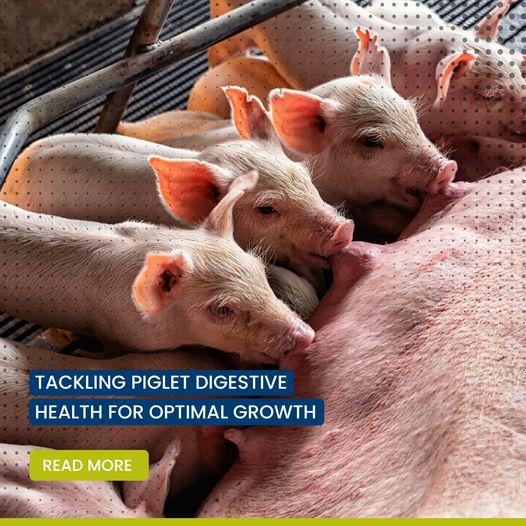Explore all the information on
Swine enteric diseases
Enteric diseases, including ileitis, salmonellosis and porcine epidemic diarrhea (PED), are common gastrointestinal disorders that, if left untreated, can result in undernourished, dehydrated pigs and possible death.
Pigs of all ages are susceptible to intestinal diseases, and diarrhea is the clinical sign common to nearly all such disorders. Infectious agents that cause enteropathies are typically transmitted via the fecal-oral route. More than 20 etiologic agents, including bacteria, viruses, and parasites, can cause primary intestinal disease in pigs. Some other viruses, including sapovirus, adenocirus, and enterovirus, also have been isolated from the intestines of pigs but are not associated with economically consequential disease.
Pig diarrhoea is one of the most frequent health problem in modern production, which can be associated with high mortality, decreased growth rates and an increase in treatment costs. The solution for an enteric disease requires a diagnosis which is based on diagnostic criteria, that must be respected to be reliable. The veterinary practitioner has the responsibility of making a final diagnosis, and based on this to make decisions concerning the management of swine health problems. The veterinary diagnostic laboratory can be an important support providing technical assistance in performing laboratory testing and consultancy activity.
Pharmacological levels of Zn in early nursery pig diets reduce the instance of post-weaning diarrhea and improve performance. However, there are growing concerns with pharmacological levels of Zn and much attention has been directed toward strategies to lower dietary Zn without negatively impacting performance. Diet acid-binding capacity-4 (ABC-4) could be an option to formulate low Zn diets. Dietary ABC-4 is the hydrochloric acid required to reach a pH of 4. The young pig has a limited...
Comments : 0
Recommendations: 0
Yihang Li (University of Delaware) Developmental plasticity during the prenatal and early postnatal periods allows animals to adapt quickly to their environment and efficiently construct organ systems crucial for survival. These adaptations, which may be irreversible later in life, can lead animals to develop beneficial survival strategies or predispose them to chronic diseases. The gastrointestinal (GI) tract is a highly adaptive organ, contending...
Comments : 0
Recommendations: 0
Nick Gallina (Purdue University) Background: Enterotoxigenic Escherichia coli (ETEC) strains are the primary perpetrators of colibacillosis in piglets, resulting in mortality and agribusiness economic woes. ETEC expressing fimbrial antigens, F4 and F18, are the predominant contributors to colibacillosis. F4 is most prevalent in neonatal diarrhea. F18 is more common in post-weaning colibacillosis. Intestinal epithelial interaction and...
Comments : 0
Recommendations: 0
Diana Ayala (Purina Animal Nutrition) Post-weaning diarrhea (PWD) is a serious health and welfare problem for the global swine industry. PWD is a multifactorial condition occurring the first 10–14 d after weaning; it is generally associated with the proliferation of pathogenic Escherichia coli groups, specifically enterotoxigenic E. coli (ETEC); however, PWD is also associated with several viral infections. Antibiotics are commonly used as a control...
Comments : 0
Recommendations: 0


APIs and Vitamin MARKET - The weak demand for the APIs
Suggested link
Yihang Li (University of Delaware) gives a presentation on the gastrointestinal tract and the impact of early life development on later life diseases in pigs, during the 11th Symposium on Gut Health in Production of Food Animals in St. Louis, USA....
Comments : 0
Recommendations: 0
Nick Gallina (Purdue University) speaks on serotypes of E. coli in pigs, and presents studies aimed at developing more effective mitigation measures using cell models, during the 11th Symposium on Gut Health in Production of Food Animals in St. Louis, USA....
Comments : 0
Recommendations: 0
Diana Ayala (Purina Animal Nutrition) presents research to determine the underlying bacterial cause of PWD and a potential vertical transmission from sows to pre-weaned piglets, as well as to determine whether a customized direct-fed microbial (DFM)-based product could reduce the pathogens isolated from affected pigs, during the 11th Symposium on Gut Health in Production of Food Animals in St. Louis, USA....
Comments : 0
Recommendations: 0
Piglet diarrhea poses a substantial challenge in swine production, presenting not just health concerns for the piglets but also significant economic implications. These ramifications encompass hindered growth trajectories, escalating medication expenditures, and in extreme situations, increased mortality rates. The initial weeks post-birth are pivotal for piglets. Their digestive apparatus, being in its nascent stage, is vulnerable to a plethora of pathogens. In traditional swine...
Comments : 0
Recommendations: 0
Introduction: Plasma of porcine origin often contains PEDV RNA which raises some concerns about biosecurity and transmission of viruses within pig populations. In contrast, it is well recognized that the addition of plasma to pig feed enhances immune reactions and also has some intrinsic inhibition on virus survival. The objective of this study was to determine if there is any benefit to the diet containing spray-dried plasma (SDP) of bovine origin during acute PEDV...
Comments : 0
Recommendations: 0
Introduction: Intervention to a PED break includes initiating a multi-facet program focusing on a planned whole herd exposure, biosecurity and sanitation protocol with the goal of PED elimination. There is no literature following a group of individual sows and gilts over a years’ time to measure fecal shedding, antibody levels and impact on performance. The objectives of this project were to evaluate: 1) Duration of shedding in individual sows 2) Individual sow antibody...
Comments : 0
Recommendations: 0
Lisa Becton (National Pork Board) talks about the painful experience of Porcine Epidemic Diarrhea (PED), as well as the improvements made and the measures taken, during this Swine It interview with host Laura Greiner....
Comments : 0
Recommendations: 0
Wes Schweer (Cargill) comments on the use of zinc oxide, as well as adjusting levels in swine diets, during this Swine It interview with host Laura Greiner....
Comments : 0
Recommendations: 0
Introduction: Porcine Epidemic Diarrhea (PED) virus is a major enteric swine disease of economic significant in many Asia country and PED was first recognized in late April of 2013 in USA. According to some research, PED virus survived in manure slurry for 28 days at 4℃ and possible longer. The main purpose of this study is to investigate the time to inactivate of the PED virus in manure slurry on farm. Materials and...
Comments : 0
Recommendations: 0
Introduction: The impact of PED outbreaks in the United States had led to a high level of awareness in the Netherlands. A baseline study in the Netherlands, conducted in the second half of 2014, confirmed the naïve status of the Dutch pig industry for PEDv. After the study was completed the first outbreak of PED occurred in the Netherlands in November 2014. Until April 2015 a total of 51 outbreaks was confirmed. These outbreaks of PED were caused by low virulent strains of...
Comments : 0
Recommendations: 0


APIs and Vitamin MARKET - The weak demand for the APIs
Suggested link
Introduction: Porcine reproductive and respiratory syndrome (PRRS) and porcine epidemic diarrhea (PED) viruses are airborne pathogens able to spread rapidly regionally. Despite this evidence, the information on the size of particles with which airborne viruses are associated while airborne in the field is limited. This association will determine the virus contribution to the airborne route, will help to explain the in between-farm transmission, as well as the...
Comments : 0
Recommendations: 0
Introduction: Lawsonia intracellularis (L.i.) is the causative agent of porcine proliferative enteropathy (PPE). PPE is a relevant economic enteric disease that causes diarrhea and reduces weight gain in growing pigs (1). The subclinical form produces as well a negative impact on performance and farm economics. L.i is endemic in most of the Spanish farms (2). The aim of this study was to evaluate the efficacy of Enterisol® Ileitis (Boehringer Ingelheim...
Comments : 0
Recommendations: 0
1 INTRODUCTION North America currently imports plant-based feed ingredients, such as soybean meal, from countries that are endemically infected with viruses of economic and pathologic significance to swine including porcine epidemic diarrhoea virus (PEDV), Seneca virus A (SVA), porcine reproductive and respiratory syndrome virus (PRRSV), classical swine fever virus, pseudorabies virus, foot and mouth disease virus (FMDV) and African swine fever virus (ASFV; Blomme et al., 2022;...
Comments : 0
Recommendations: 0
Introduction: Post-weaning complications in piglets are characterized by heightened susceptibility to infection, diarrhoea, atrophy of small intestine structure and reduction in body weight. The ban on prophylactic antibiotics and environmental concerns with usage of excessive zinc demands for identification of safer alternatives to treat post-weaning complications. Feed additives that maintain homeostasis between the intestinal epithelial layer, intestinal microbes and the...
Comments : 0
Recommendations: 0
Introduction: Diarrhoea during the first week of life is a big concern in many Danish pig herds - not least since the suspected introduction of “New Neonatal Diarrhoea Syndrome.” The study investigates pathogens and management-factors associated with these problems. Materials and Methods: A total of 107 herds including 55 Case-herds with diarrhoea during the first week of life and 52 Control-herds without diarrhoea as a herd problem filled in...
Comments : 0
Recommendations: 0
Introduction: Weaned piglets suffer many stressors such as sudden change of feed, change of pigs groups and passive protection decrease with ageing. The aim of this study was to investigate the effect of the inclusion of a free and buffered organic acids blend (OAs) to drinking water (DW) of weaned pigs on performance in presence or absence of medication to control enteric disease. Materials and Methods: One-hundred and forty (140) pigs in a conventional herd...
Comments : 0
Recommendations: 0




.jpg&w=3840&q=75)



.jpg&w=3840&q=75)

.jpg&w=3840&q=75)






.jpg&w=3840&q=75)












